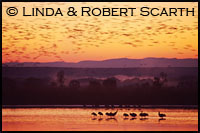introduction - galleries - technique - catalogue - notes - links - contact - blog - deep nature

Bosque del Apache Sunset
Among our favorite things are wild geese with the moon on their wings (a la The Sound of Music). And every couple of years in November we head for Bosque del Apache NWR near Socorro, New Mexico to enjoy and photograph Snow Geese and Sandhill Cranes, along with other species and the graphic desert landscapes punctuated by lakes and ponds on the refuge. Of course, the sound of the crane music along the Rio Grande River in winter is as wonderful as it is along the Platte River in Nebraska each early spring. The Sandhill Cranes at Bosque are much more approachable, as they feed on the corn fields that are planted for them, than those scavenging last year?s residue in central Nebraska as they prepare for the push to their breeding grounds far to the north.
Watching family groups of geese and cranes mingle in a great community of birds is fascinating. Some young geese have learned their lesson well that humans must be treated with suspicion. We have seen youngsters stare at the photographers who line the road at the north end of the circle drive and turn frequently to their parents, making plaintive distressed sounds. The young geese seem dismayed at their parents lack of concern for those creatures on the other side of the ditch as they graze and pick corn and roots. Blue Geese (really the blue phase Snow Goose) add color to the acres of white geese seen on lakes, along roads and overhead as they lift off, loop the sky in figure eights and land again.
The cranes move about in stately trios and foursomes in family groups that will remain until during the migration north in the spring. Young cranes keep their juvenile bell-like voices into their yearling year. The tinkling of the crane bells is like a set of temple bells in a Japanese garden. Several years ago we spent a spring night in a ?dog box? blind along the Platte River and listened to the soothing lullaby of the adults punctuated by the sweet jingle of the soon to be yearlings as they spent the night in the river.
Cranes are revered in Asia and often have a place in myths and fairy tales. Origami (folded paper) cranes by the thousand have become an international symbol and call for peace. American Indian stories sometimes feature heroic and self-sacrificing cranes. The Whooping Crane is becoming a contemporary symbol of retreat from the brink of extinction. Sandhill cranes are returning to nest in Iowa. They are ancient and new to all who see them.
Again, this year we will spend Thanksgiving Day on the ?road to Bosque?, with probable stops at several other national wildlife refuges and known wintering grounds of waterfowl. Bosque de Apache NWR is one of the premier bird photography sites in the U.S., especially in late autumn when the cranes and geese are feeding near the road. The refuge workers knock down successive swaths of corn in the fields at the north end of the circle drive through the refuge. They start near the road after many migrants have arrived and gradually work their way through the fields as winter progresses.
As well as cranes and a variety of waterfowl, raptors, game birds and small birds, the refuge has a complement of the most cosmopolitan of canines, the coyote. We have seen a group (surrounded by Ravens) dining on goose out in one of the fields while the cranes warily watched from a distance. One of our best series of Bosque photos is the result of a coyote walking out of the standing corn toward a huge mixed flock of geese and cranes who rose in unison as the row of photographers caught their breaths and just kept clicking as if all had motor drives. The sight, emotions and sound is again real every time we look at one of the ?blast off? series.
We hope to meet some of you at one of the overlooks at Bosque.
? Linda & Robert Scarth, 2006.
First published in NatureScape News, 1 (12), B2, 2006.
